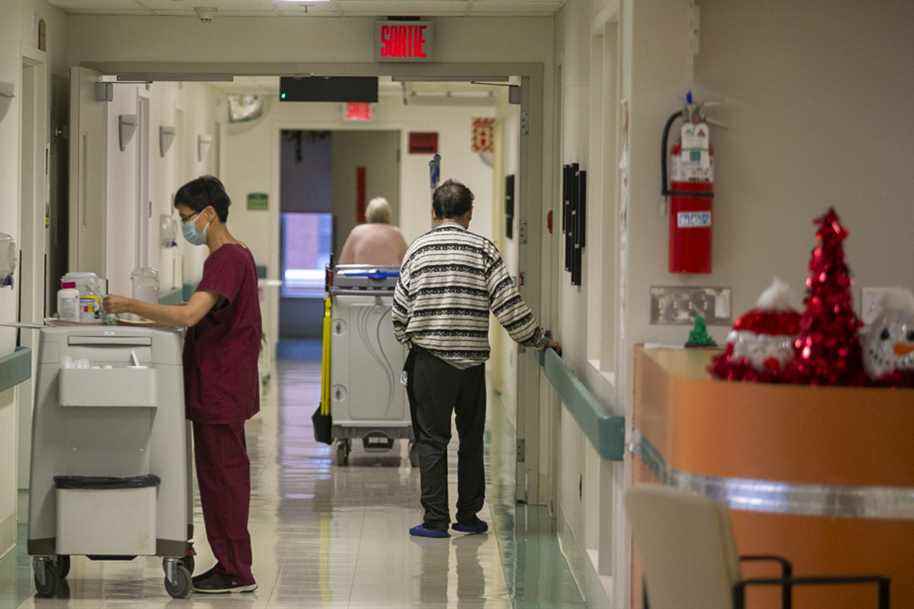In January 2020, when the pandemic was not yet on the radar screen of Quebec authorities, employees of the Montreal Chinese Hospital were already wearing masks and voluntarily isolating themselves from their families.
While we have been hearing for a few weeks, at the inquest of coroner Géhane Kamel, of the shortcomings in certain CHSLDs that caused a massacre at the start of the pandemic, the Montreal Chinese Hospital has just been rewarded for its good “Performance”: He has known only four cases of COVID-19 among his residents, no outbreak, and one death.
During the first wave, in the spring of 2020, there were no cases among its residents.

PHOTO FRANÇOIS ROY, THE PRESS
A few weeks ago, the establishment received the Medal of the National Assembly for its remarkable location.
A few weeks ago, the establishment received the Medal of the National Assembly for its remarkable location.
How did this CHSLD, which hosts 128 residents, in Chinatown, resist the virus?
Employees, mostly of Chinese descent, began to hear about the dangers of the coronavirus in January 2020, from their families and friends still living in China, says the coordinator of the establishment, Sandra Lavoie.

PHOTO FRANÇOIS ROY, THE PRESS
Sandra Lavoie, CEO of the Montreal Chinese Hospital
Seeing what was happening in China, they got themselves masks and visors, even if there was no instruction on this subject with us. They applied the measures they saw in China.
Sandra Lavoie, coordinator of the Montreal Chinese Hospital
“We bought masks with our own money, on Amazon,” confirms Savan Inthavong, beneficiary attendant.
The CEO gave permission to use these means of protection, because some employees had gone on a trip to China and she knew there were certain risks. “And it reduced anxiety among the employees, who work a lot as a team,” she says.
Voluntarily restrict visits
Another initiative: employees decided not to meet their families on the occasion of the Chinese New Year, which took place on January 25, 2020, to avoid the risk of contamination.
Chinese New Year celebrations scheduled to take place at the facility have also been canceled.
“The families of the residents, the people of the community, decided themselves to restrict their visits, because they were aware of the risks, they self-discipline,” adds Sandra Lavoie.
Local resident Fook Tim Chan, 96, himself asked his eight children not to visit him again.

PHOTO FRANÇOIS ROY, THE PRESS
Fook Tim Chan, 96, resident of the Montreal Chinese Hospital
Before, my family came every week, my children even brought me food. But I told them to stop coming because of COVID.
Fook Tim Chan, 96, resident of the Montreal Chinese Hospital
Even today, he is satisfied with virtual contact, through the screen of an iPad, with his children.
“We have very good services here, and a very good protection system,” said Mr. Chan, who is very proud of the Medal of the National Assembly received by the establishment.
“We are like a small family”
Unlike other CHSLDs, the Chinese Hospital has made very little use of the services of employees from outside or from agencies, which has also enabled it to close the door to the virus.

PHOTO FRANÇOIS ROY, THE PRESS
Savan Inthavong, beneficiary attendant
“Here, we are like a small family,” explains Savan Inthavong. When it was understaffed, rather than bringing in someone from outside, someone from the team volunteered to work overtime. ”
There were still 15 cases of COVID-19 among the employees, but no contamination between them or with the residents.
All these measures, this teamwork and this awareness of the community have enabled the establishment to do much better than others, says Sandra Lavoie.

PHOTO FRANÇOIS ROY, THE PRESS
There were still 15 cases of COVID-19 among the employees, but no contamination between them or with the residents.
Ironically, by the time all of these precautions were taken, employees were discriminated against because of their Chinese origins, which some linked to the source of the virus.
“I wore a mask on public transport long before anyone else,” recalls Savan Inthavong. But when people saw that I was Asian, they changed places on the bus so as not to be next to me. People were suspicious of us, we went to get a coffee and we were told to go back to our country. We were labeled as public dangers. ”

